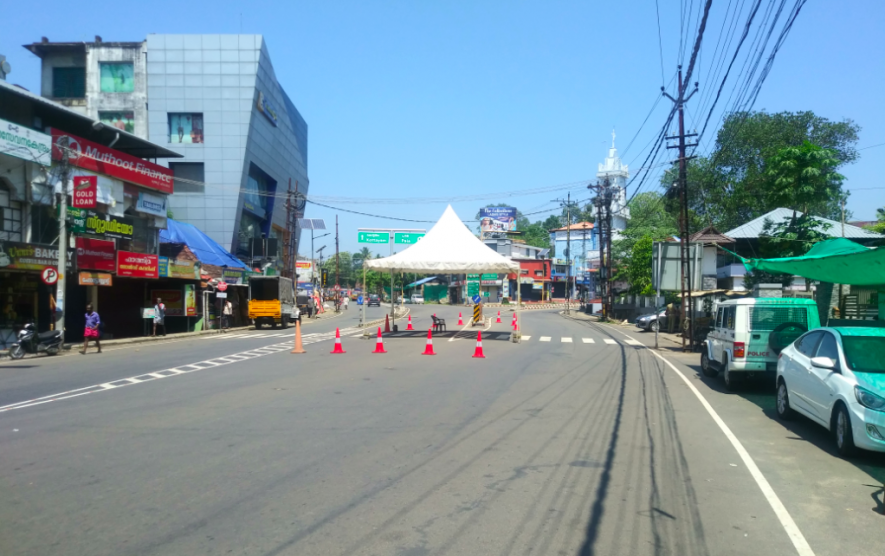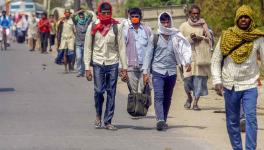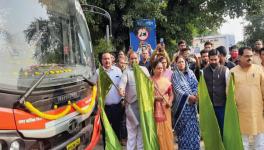Innovative Solutions are Required for Mobility in a post-COVID-19 Age

Empty street during COVID-19 pandemic lockdown, photographed from K.K. Road (NH 183) at Ponkunnam.
What will be the future of urban mobility, during the pandemic and post-COVID-19? There are no definitive answers to the question. A number of cities in the world that had focused on public transport as a sustainable model of mobility, are now debating how to make it safer. Safer, because even when the pandemic is over, there will be the threat of more frequent epidemics. Safe public transport is a challenge which urbanists are still grappling with.
There are two anecdotes I would use to give some context. The first one is from the period when we were coming up with a smart city plan for Shimla. Two adept officers, the Commissioner and the Assistant Commissioner, were of the opinion that access to water in the city should be our first priority. This was also because the town was grappling with an acute water crisis, both in terms of adequate quantity and potability. To our surprise, however, through a widespread survey the people of the city instead chose mobility in the city their priority; in the year 2016. Invariably, in most of the smart city plans, mobility figured as the top priority for city planning.
The second one is recent, from a few days ago. I ended up almost quarreling with policemen at a post in Lakkar Bazar, Shimla. They had stopped two young cyclists from riding their bicycles, calling the area a no-cycle zone. I had to point out that the smart city plan of the town lays stress on the greater use of cycles as an additional mode of non-motorised transport.
Coming back to mobility, what could be viable and sustainable modes of public transport? Firstly, it is important to understand the challenges in mobility in major cities across the world.
An interesting data sample released recently showed there was a substantial fall in people’s movement given the lockdown imposed by various governments. The relative change in mobility in India, however, was an incredible -5800% – the country had come to a literal halt. The change in the number of visitors at workplaces was -51%, and time spent at home increased by 15%, given that most of the white-collar workers worked from home.
However, this cannot remain as the status quo. People will start going out to work and for various other reasons. From ancient Rome to modern Atlanta, the shape of cities has been defined by the technologies that allow commuters to get to work in about 30 minutes, says this Bloomberg piece. In India, seven percent of our total time in the day is spent on commuting – about two hours, on an average. That number is higher in metropolitan cities, and these numbers are among the highest in the world.
As is evident from the data, a large number of commutes take place either on foot or via public transport. It is mistaken idea to think that most of India commutes to work via motorised transport. Data revealed by the Registrar General of India regarding the commuting patterns of 200 million working class Indians, those into non-agricultural operations, presents an interesting picture for mobility strategies in the future.
Of the total, nearly 30% of the people do not commute at all. Among the 140 million workers who commute to work, the distances they cover are quite small. Almost 25% of commuters travel less than a kilometre, and another third travel between two and five kms. Bicycling is another popular mode of transport with almost 13% using it to go to their workplaces. The share of public transport is 18% while private transport’s share is 15%.
Even in mega-cities, walking is the most common mode of commuting. Kolkata has the largest share of pedestrians at 39%, followed by Mumbai at 31%, Bengaluru at 29%, Delhi at 26% and finally Chennai with 20%.
In such a scenario, it important for urban planners to factor-in these commuting patterns – pedestrians-at 30%, those on bicycles at 13%, and those on the bus, at 16%. In a post-COVID-19 situation, the rich and the upper-middle-class sections will want for a greater use of private cars, which would further harm means of sustainable development.
We have seen how the poor subsidises the rich in the cities. Despite the clarity, urban planning has mostly been for the affluent sections; flyovers and widened roads are laid out so that their giant guzzlers can move fast. The reality is that more flyovers mean more cars, negating the construction of such infrastructure. In Shimla, sections of the middle-class have forced the state government to allow motorised vehicles even in centuries-old restricted roads; from Boileauganj to Vidhan Sabha and Sanjaulli to IGMC.
Despite the fact that most of who commute are either pedestrians or bicycle riders, the infrastructure in cities is the least in proportion to their needs.
What Needs to be Done
The largest number of commuters must get the largest share in both the planning and execution process. Walking needs to be encouraged, and more spaces should be created for pedestrians. Roadside sanitation facilities must be made available with adequate quantities of water and soap. Similarly, cycling should be encouraged as a means of transport and the move should be aggressively implemented by the city government.
Interestingly, while Atlas Cycles shut its manufacturing facility in the NCR region, there has been an increase in the sale of bicycles recently, both, in the ones bought by the working class, and some high-end bicycles in the cities. During the pandemic, cycle sales boomed, especially in the US, and in other developed countries as well. Local cycle shops in Shimla sold as many cycles in the last three months as they had in the last three years.
However, there must be safe infrastructure and a proper plan to make cycling sustainable. There are two contradictory examples. The first is from Chandigarh where cycle tracks have been laid out. It also has a mechanism to ensure that the cycle tracks are not usurped either by the motorists, or encroached upon. The Chandigarh police, in consonance with the city administration, does the monitoring exercise. Another example is that of Noida, where extensive cycle tracks were constructed by the previous government led by Akhilesh Yadav; however, in the absence of proper monitoring, the tracks have been completely usurped by encroachments. The Delhi government is also promulgating a move to construct such tracks. It is an appreciated step, but without proper planning and conditioning mindsets for a couple of years, the mere construction of infrastructure will not serve its purpose.
In the process of working on my fellowship in urban mobility in Leipzig, Germany, I learned that the city has a dedicated team of bicycle officers, at par with our traffic cops. Conventional traffic police cannot monitor such tracks, and there has to be a dedicated team equipped with know-how and the potential to act. As a result, the bicycle officers are not just limited to cycle tracks, they build an environment in the city for safer bicycle movement.
Innovative forms of promotion of bicycles will have to be developed. Immediately after winning the deputy mayor election, I met the chief minister of Himachal Pradesh, P.K. Dhumal. He had suggested the incentivisation of commuters using bicycles as their mode of commute. It may sound trivial but the idea could bring about change.
Secondly, it is important that change is brought in from the top. Leader must preach and practice, and it being done in many countries in the world. This pandemic gives us the opportunity to explore such ideas and implement them.
The third aspect will be to further strengthen public transport. Initially, there will be a behavioural change due to the pandemic, and people would avoid using it. But, a safer environment can bring about a change. Proper sanitisation, the use of masks and other hygienic methods can bring about the desired change.
It is estimated that to make commutes safer for people after the lockdown, the Delhi metro will have to enhance its capacity six times over, while Mumbai’s trains will have to boost their services by 14-16 times. Innovative forms of revenue generation will have to be worked out, and just ‘enhancing the fare model’ will have to be revised; for the simple reason that public transport is a social responsibility.
Some interventions for safer travel in public transport could be sanitisation; hygiene guidelines while introducing modification to ensure safety of passengers and drivers and conductors; dedicated transportation to workers from their home to workplaces; ensuring closing down of streets for vehicular traffic to allow for pedestrians and cyclists.
The writer is former deputy mayor of Shimla. The views are personal.
Get the latest reports & analysis with people's perspective on Protests, movements & deep analytical videos, discussions of the current affairs in your Telegram app. Subscribe to NewsClick's Telegram channel & get Real-Time updates on stories, as they get published on our website.
























